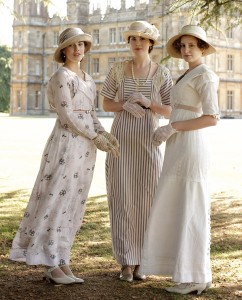Vintage
Vintage Sewing: Literal or Figurative?
Vintage Pajamas: Final
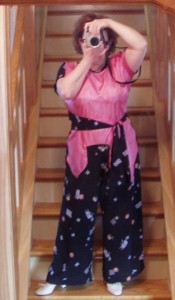 OK, so here we are, at the end. I’m very pleased with this. The rayon-poly crepe is just the right weight for this; I only wish I’d had enough for the whole thing. the bi-color front effect is very cute but I think it would look much more elegant in all one fabric. The increased back bodice piece extension did exactly what I had hoped in terms of keeping the back cross-over closed (yay, me). It’s really a very easy piece to put together and I could see someone using this for an outfit for easy summer outdoor entertaining. I give the pattern two big thumbs up!!
OK, so here we are, at the end. I’m very pleased with this. The rayon-poly crepe is just the right weight for this; I only wish I’d had enough for the whole thing. the bi-color front effect is very cute but I think it would look much more elegant in all one fabric. The increased back bodice piece extension did exactly what I had hoped in terms of keeping the back cross-over closed (yay, me). It’s really a very easy piece to put together and I could see someone using this for an outfit for easy summer outdoor entertaining. I give the pattern two big thumbs up!!
Pattern:Decades of Style Pattern 3001 Kitchenette Pajamas
Fabric: Rayon Polyester crepe, which I bought in Ithaca, New York at Homespun Boutique (which is just off the Commons, if you are familiar with the city). Unfortunately, they do not do business over the internet, but I recommend them highly if you are in the area (and since Ithaca is right in Upstate New York’s wonderful Finger Lakes wine country, I recommend a trip here highly too). The owner has a lovely, interesting, very well-chosen (I’m not going to use the word ‘curated’ because I really do think that refers to exhibitions and museums) selection of fabrics and yarns and I’ve found great buys there on the clearance shelf. The front of the bodice is made out of poly lining that I had in the stash.
Notions: Nothing. No buttons, snaps, zippers, or clips were used in this project.
Vintage Pajamas: Fiddly Bits at the Front — UPDATED!
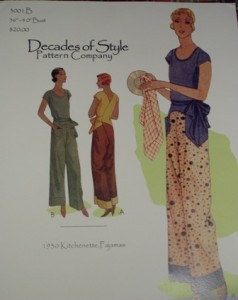 Ahem. As we discussed the last time, Aunt Toby is making what is really a rather fancified housedress cum jumpsuit with the pattern (originally from 1930) shown at the top. And I ran out of fabric for the whole thing, so the front bodice is made out of rather Schiaparelli-esque pink poly lining (hey, I go with what I’ve got in the stash, ya know?). And today’s rather short report is on the front.
Ahem. As we discussed the last time, Aunt Toby is making what is really a rather fancified housedress cum jumpsuit with the pattern (originally from 1930) shown at the top. And I ran out of fabric for the whole thing, so the front bodice is made out of rather Schiaparelli-esque pink poly lining (hey, I go with what I’ve got in the stash, ya know?). And today’s rather short report is on the front.
Now, because I’ve made the front bodice out of a lighter colored fabric (lucky you), you can see a lot better the fiddly bits in the front – reference the bicolored-version of the jumpsuit on the right hand side of the photo. Now, I’m not sure exactly why the front was designed in this way with these two rather startlingly shaped tabs hanging down and intersecting the leg portions of the jumpsuit, but they do.
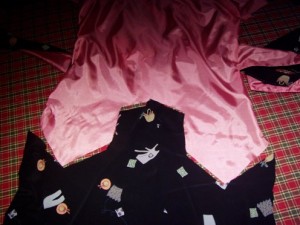 As you can see from this photo (and a poorly lit photo it is; my apologies), these tabs literally go down about as far as the center front crotch seam does. If you have enough fabric to make the jumpsuit all one fabric, you just might miss the seaming, especially if you are using a print. Someone using a one-color fabric might want to emphasize the seaming with piping or contrast stitching, but I figured shocking pink against the navy blue would be startling enough. The way you put this together is this:
As you can see from this photo (and a poorly lit photo it is; my apologies), these tabs literally go down about as far as the center front crotch seam does. If you have enough fabric to make the jumpsuit all one fabric, you just might miss the seaming, especially if you are using a print. Someone using a one-color fabric might want to emphasize the seaming with piping or contrast stitching, but I figured shocking pink against the navy blue would be startling enough. The way you put this together is this:
1) Sew the front center crotch seam.
2) Sew the back center crotch seam.
3) Put the front and back together and sew the side seams and the inner leg seams.
4) Match the center crotch seam at the top edge with the center of the front bodice piece (you did mark the center, right?). Also match all the markings, the corners and any other oddly shaped thing that is sticking out or is cut into the pattern pieces (and as you can see, there are a bunch of them but trust me, all those ‘outie’ and ‘innie’ corners do match.
5) Match the side seams on the upper bodice piece and the leg side seams.
6) Match all the other markings on the back pants pieces and the back of the bodice.
7) Start at one edge (I don’t think it matters really) and sew alllll the way around, being a mite careful at all those inner and outer corners on the tabs on the front bodice/leg meet ups. Carefully clip into the corner bits.
Press. If you want to stitch again, do so now.
Hang it up, and repeat these words, “Oh, what a good sewer I am!”
Next time: Finishing up! (Don’t forget the Rudy Vally records)
UPDATE: Number 7 above: Start at one edge and go all the way around? Well, that worked when I made the muslin out of cotton seersucker. When I tried it with this rayon poly ‘whatever it is”, it made the top layer scoot ahead and I ended up with a mess. So, I took (sigh. Frog time again) it all out and started from the center and went in one direction to the center back edge and then went back to the center and went the other way. No problems this time. See photo: 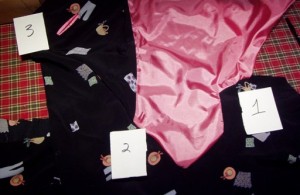 See number 1? That the center seam on the pants legs and the center of the bodice front. Number two is the side seam for both the bodice and the pants, and number 3 is the center back of the right back bodice. And that’s the order I sewed in, also. Then I went back to number 1 and did the other side. Worked beautifully and I did not have any pucker or other issues.
See number 1? That the center seam on the pants legs and the center of the bodice front. Number two is the side seam for both the bodice and the pants, and number 3 is the center back of the right back bodice. And that’s the order I sewed in, also. Then I went back to number 1 and did the other side. Worked beautifully and I did not have any pucker or other issues.
Vintage Pajamas – Some fiddly bits
 I love vintage patterns. Sometimes I think it’s because of the artwork on the envelop front but in general there seems to be a bit more romance involved in any case. And, in Aunt Toby’s ever-expanding search for something to wear while asleep and/or lounging about that is not sweatpant/athletic shorts/tee shirt, I found this reworked pattern from Decades of Style, which is called ‘Kitchenette Pajamas”. (more…)
I love vintage patterns. Sometimes I think it’s because of the artwork on the envelop front but in general there seems to be a bit more romance involved in any case. And, in Aunt Toby’s ever-expanding search for something to wear while asleep and/or lounging about that is not sweatpant/athletic shorts/tee shirt, I found this reworked pattern from Decades of Style, which is called ‘Kitchenette Pajamas”. (more…)
(Collar) Stay…just a little bit longer….
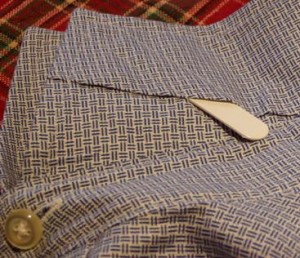 (WARNING: PICTURE HEAVY) In the DH’s closet, there are two basic types of shirts: button-down shirts and what he refers to as ‘dress shirts’. Now, I only learned this recently, but the ‘button-down’ shirt (which really refers to there being a collar whose points are secured to the shirt itself with buttons) is actually not a US invention. One of the members of the Brooks Brothers family, on a European trip in the late 1800s, saw how polo players there did this to prevent their shirt collars from flying up into their faces during play; he obviously thought it was a neat idea because he brought it back and convinced the family company to start producing what they called ‘polo(tm) button-down’ dress shirts in 1896. These shirts were always seen as something rather sporty and casual until college boys started wearing them in the 1950s, (more…)
(WARNING: PICTURE HEAVY) In the DH’s closet, there are two basic types of shirts: button-down shirts and what he refers to as ‘dress shirts’. Now, I only learned this recently, but the ‘button-down’ shirt (which really refers to there being a collar whose points are secured to the shirt itself with buttons) is actually not a US invention. One of the members of the Brooks Brothers family, on a European trip in the late 1800s, saw how polo players there did this to prevent their shirt collars from flying up into their faces during play; he obviously thought it was a neat idea because he brought it back and convinced the family company to start producing what they called ‘polo(tm) button-down’ dress shirts in 1896. These shirts were always seen as something rather sporty and casual until college boys started wearing them in the 1950s, (more…)
Shirt a la Coop Meets the Gigantic Neckband
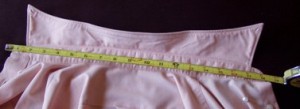 One of the things about making men’s shirts is that generally speaking, you must count on observers seeing only about 25% of the shirt unless the shirt is being worn alone, without a jacket or a vest or a sweater. Then, all of it except for the portion tucked into the person’s slacks can be seen. But generally, with a shirt such as this one, it would be worn with a sweater or a sport coat, so at the most, the center 5-6″ of the front, the collar, and the cuffs are going to be seen. (more…)
One of the things about making men’s shirts is that generally speaking, you must count on observers seeing only about 25% of the shirt unless the shirt is being worn alone, without a jacket or a vest or a sweater. Then, all of it except for the portion tucked into the person’s slacks can be seen. But generally, with a shirt such as this one, it would be worn with a sweater or a sport coat, so at the most, the center 5-6″ of the front, the collar, and the cuffs are going to be seen. (more…)
Making a Man’s Shirt – a la Coop
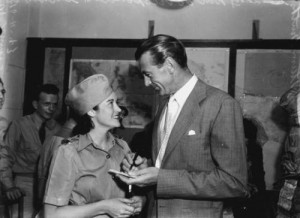 Once upon a time, I saw a PR photo of Gary Cooper (“Coop”) which struck me strongly in terms of how a) fashionable he was for the period and b) how soft the collar on his shirt looked in comparison to what we are used to today. Now, for the time, unless an actor was being photographed in movie costume as a ‘movie still’ shot for magazines, newspapers and advertising or for the movie posters, that actor was being photographed in street or evening clothing as part of the studio PR campaigns (as you recall, they were under contract to movie studios and were seen as assets to be used to promote the studio itself as well as promote themselves to build a fan base). As a matter of fact, many actors (Cooper included) were used in magazine editorial and in photo advertisements (I think Cooper did advertising not only for Knox Hats but also for a high end men’s shirt company as well). So, the ‘formality’ of the dress (which as I recall was a tweed sport coat, gingham shirt and knit tie, an outfit that would have been seen as ‘high end country house’ clothing at the time. He was probably also wearing wool flannel slacks and suede shoes as well) was really part and parcel of the shot. (more…)
Once upon a time, I saw a PR photo of Gary Cooper (“Coop”) which struck me strongly in terms of how a) fashionable he was for the period and b) how soft the collar on his shirt looked in comparison to what we are used to today. Now, for the time, unless an actor was being photographed in movie costume as a ‘movie still’ shot for magazines, newspapers and advertising or for the movie posters, that actor was being photographed in street or evening clothing as part of the studio PR campaigns (as you recall, they were under contract to movie studios and were seen as assets to be used to promote the studio itself as well as promote themselves to build a fan base). As a matter of fact, many actors (Cooper included) were used in magazine editorial and in photo advertisements (I think Cooper did advertising not only for Knox Hats but also for a high end men’s shirt company as well). So, the ‘formality’ of the dress (which as I recall was a tweed sport coat, gingham shirt and knit tie, an outfit that would have been seen as ‘high end country house’ clothing at the time. He was probably also wearing wool flannel slacks and suede shoes as well) was really part and parcel of the shot. (more…)
